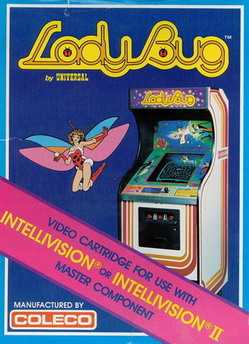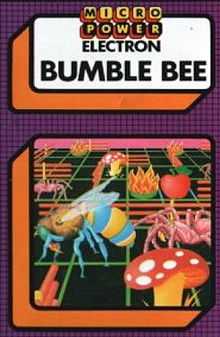Lady Bug (video game)
| Lady Bug | |
|---|---|
 | |
| Developer(s) | Universal Games |
| Publisher(s) | Universal Games. Home versions licensed via Taito. |
| Designer(s) | Kazutoshi Ueda |
| Platform(s) | Arcade, ColecoVision, Intellivision |
| Release date(s) | 1981 |
| Genre(s) | Maze |
| Mode(s) | Up to 2 players, alternating turns |
| Cabinet | Upright, cocktail |
| Arcade system | Main CPU: Z80 (@ 4 MHz) Sound Chips: 2x SN76489 (@ 4 MHz) |
| Display | Raster, 192 x 240 pixels (Vertical), 32 colors |
Lady Bug is an insect-themed maze chase arcade game produced by Universal Games and released in 1981. Its gameplay is similar to Pac-Man, with the primary addition to the formula being gates that change the layout of the maze when used. The arcade original was relatively obscure, but the game found wider recognition and success as a launch title for the ColecoVision console.
Description
The goal of Lady Bug is to eat all "flowers", hearts and letters in the maze while avoiding other insects. The player is represented by a red, yellow, and green character resembling a ladybug while the enemy insects' appearance varies by level. The border of the maze acts as timer, with each circuit signaling the release of an enemy insect from the central area, up to (generally) a maximum of four. The speed of the circuit increases on stages 2 and 5.
Unlike Pac-Man, the player can alter the layout of the maze by shifting any of the twenty green gates. It is not possible to completely isolate a portion of the maze through gate-shifting.
When the fourth enemy insect enters the maze, the central area will show a level-specific vegetable. Eating a vegetable gives the player bonus points and immobilizes the enemy insects for several seconds, though touching them is still lethal. The randomly placed skull icons are lethal to ladybugs and enemy insects. An enemy insect who dies returns to the central area. Once a vegetable is eaten, the central area will remain empty unless an enemy insect dies and is re-released, revealing a new vegetable. A ladybug who dies will shrink from view and be briefly replaced with icons resembling the stereotypical wings and halo of an angel.
The colors of the hearts and letters cycle through a short red, a middling yellow, and a longer blue. The point values are as follows:
- Flower: 10 points (20, 30, or 50 points with appropriate multiplier)
- Blue letter/heart: 100 points (200, 300, or 500 points with appropriate multiplier)
- Yellow letter/heart: 300 points (600, 900, or 1500 points with appropriate multiplier)
- Red letter/heart: 800 points (1600, 2400, or 4000 points with appropriate multiplier)
- Vegetable: Starts at 1000 points, increases by 500 with each level to a maximum of 9500 points on level 18. Beyond this level, the vegetable's appearance (horseradish) and point value remain fixed.
If a heart is consumed while it is blue, a point multiplier will come into effect, indicated by the blue section in the upper right corner of the screen. The first blue heart doubles all point values, the second triples them and the third quintuples them. This multiplier lasts until the level is complete. Eating hearts while they are yellow or red offers no benefit beyond the points collected.
At each level, the maze will contain three letters. One will be randomly selected from the set of {S, P, C, I, L} (which appear only in SPECIAL), one will be randomly selected from the set of {X, T, R} (which appear only in EXTRA) and the third will be an A or an E (which appear in both words). A secondary goal of the player is to complete the words SPECIAL (indicated in red in the top left corner) and EXTRA (in yellow at top center). If, for example, a letter S is consumed while it is red, the corresponding letter in the word SPECIAL will change from grey to red. Eating an S while it is any other color (or if the S in SPECIAL is already red) offers no benefit beyond the points collected. Completing the word SPECIAL rewards the player with a free game, while completing EXTRA gives the player an extra life. Completing either word causes all its letters to return to normal and immediately advances the player to the next level.
Ports and clones

Lady Bug was adapted to the home video game systems Intellivision and ColecoVision. In the ColecoVision version, completing SPECIAL puts the player into a bonus level (known in-game as a "Vegetable Harvest") where the goal is to consume as many randomly placed vegetables as possible within a fixed time. The SPECIAL register does not appear in the Intellivision version.
A clone entitled Bumble Bee (replacing the main character with a bumblebee and the enemies with spiders) was released in 1983 and 1984 by Micro Power for the BBC Micro, Acorn Electron, and Commodore 64.
In 1982, a catalog of Atari 2600 cartridges manufactured by Coleco said that an Atari 2600 version of Lady Bug would be released, but Coleco never released the game.
Reception
Lady Bug was not a hit in the arcade,[1] but was recognized for its originality within the maze game genre. In January 1983, the 1982 Arcade Awards gave it a Certificate of Merit as runner-up for Most Innovative Coin-Op Game.
The ColecoVision version was popular.[1] In January 1984, it won the Videogame of the Year award at the 1983 Arcade Awards, tied with the Atari 2600 port of Ms. Pac-Man.[2] The game has received appreciation in later years, being praised by some as "the most challenging of the Pac-clones... It was, and still is, one of the best [of the clones]."[3]
See also
- Mouse Trap
References
- ↑ 1.0 1.1 Pearl, Rick (June 1983). "Closet Classics". Electronic Games. p. 82. Retrieved 6 January 2015.
- ↑ "Electronic Games Magazine". Internet Archive. Retrieved 1 February 2012.
- ↑ Jonah Falcon. "GOTW: Ladybug". Gamespy.
External links
- Lady Bug at the Killer List of Videogames
- Lady Bug guide at StrategyWiki
- Classic Gaming Game of the Week article
| ||||||||||||||||||||||